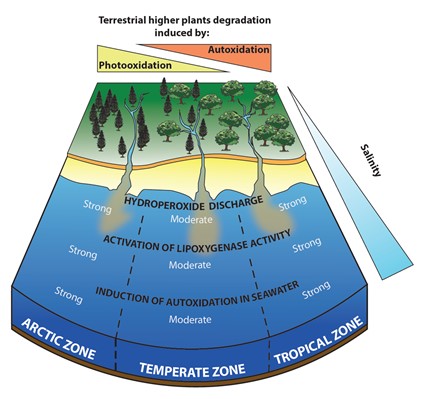Marie-Aimée Galeron (OT-Med PhD student)
Aurélie Portas (OT-Med Engineer)
Rontani J-F., Vaultier F., Bonin P., Guasco S. (MIO)
Radakovitch O. (CEREGE)
Because riverine particulate organic matter (POM) consists of already highly degraded residues of terrestrial organisms (with a high content of lignin), it is generally considered as being refractory to decomposition in the ocean. It is surprising then that only a small fraction of the organic matter preserved in marine sediments appears to be land-derived. This suggests either that global budgets and distribution estimates are greatly in error, or that POM of terrestrial origin undergoes rapid and remarkably extensive remineralization at sea.
This project aims to understand the degradation of TOM (total organic matter) discharged by the Rhône River. into the Mediterranean. Thanks to seasonal sampling of POM and different laboratory experiments, we will try to explain why biotic and abiotic degradation of TOM is so intensive in seawater.
This original project is based on a ‘cross-biome’ study, i.e. taking into account both the terrestrial and aquatic environments and exchanges of matter and organisms between these two environments.
Using new lipid tracers specific to the degradation of terrestrial higher plants at the mouth of the Rhône River, we confirmed during the M-A. Galeron PhD thesis (funded by OT-Med) the role played by autoxidation in the degradation of terrestrial POM (TPOM) in estuaries. We could propose for the first time the involvement of lipoxygenase (LOX) activity in the induction of autoxidation in mixed waters. We showed the role played by salinity in the induction of this LOX activity and provided an explanation for the differences observed in estuarine autoxidation levels (Figure 1). During the BALTOMS project (following this PhD work), we could then demonstrate that the increase of salinity in the Rhône estuary strongly impacts the composition of the bacterial community associated to TPOM, which gets closer gradually of that observed in the sea. Priming effects (enhanced mineralization of TPOM in the presence of fresh substrates from algal sources) appeared to play an important role in the biotic degradation of TPOM in the Rhône Estuary. The potamoplankton (freshwater plankton) formed within the Rhône River (dominated by diatoms) appeared to be a co-substrate well suited for the degradation of TPOM.

Abiotic degradation of terrestrial higher plant material discharged by rivers in Arctic, temperate and tropical zones
General information on the BALTOMS project / Information générale sur le projet BALTOMS : https://www.mio.osupytheas.fr/fr/cem/baltoms
Video summarising the BALTOMS PhD project : Video résumant le projet de thèse BALTOMS
This study is be integrated to the MERMEX (https://mermex.com.univ-mrs.fr/) program and more particularly to the WP3-Rivers work package


